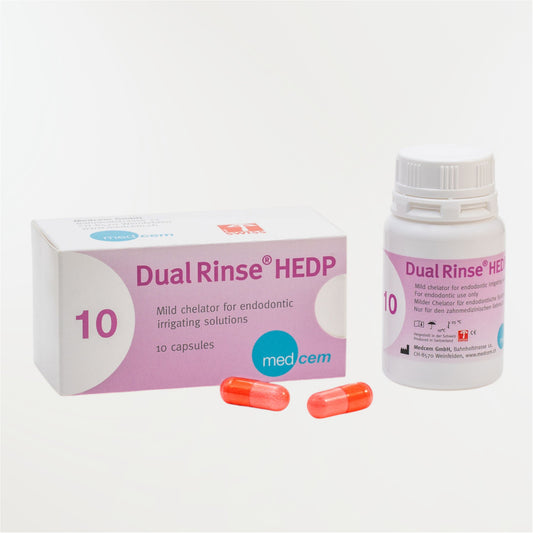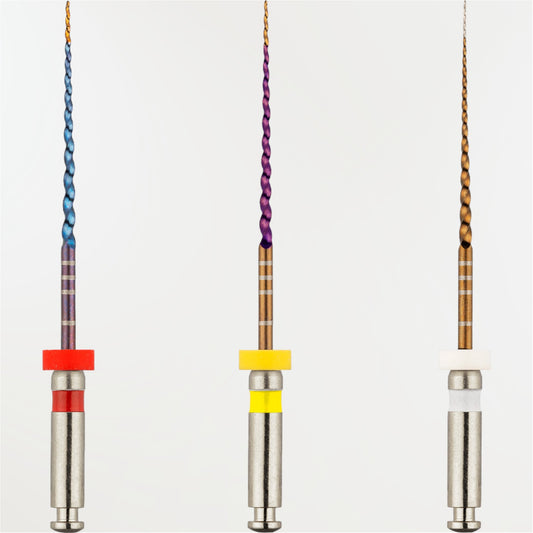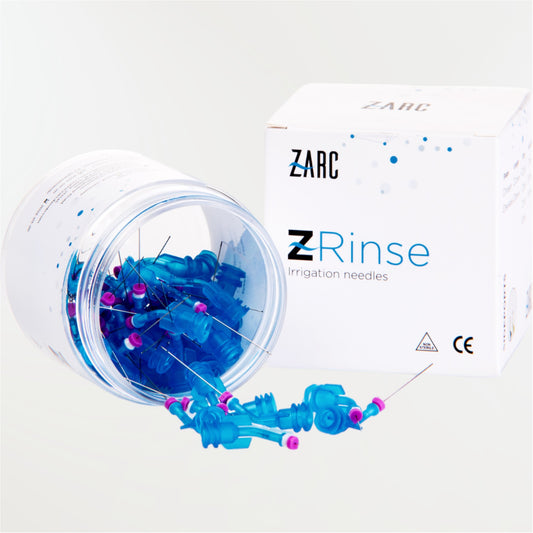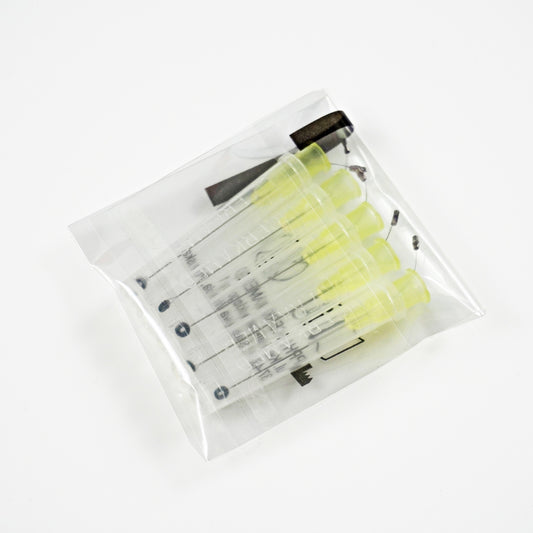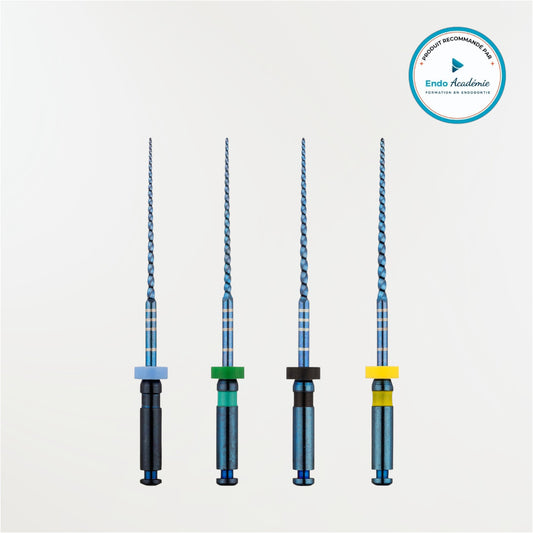Since its appearance in the late 1990s, mechanized endodontics has come a long way.
Evolution has long been made exclusively on instrumentation. Since the appearance of reciprocity in 2011, manufacturers have also made progress on engines.
- How to choose your engine?
- What differentiates them from each other?
- Can we compromise?
So many points that we will try to clarify in this article to help you choose yours.
Dedicated motor or contra angle reducer?
With the advent of mechanized endodontics, investment in a motor seemed superfluous. Several manufacturers then offered high-reduction contra angles which plug into the micro-motor of the chair.
The undeniable advantage is that this avoided having an additional device. In addition, being completely mechanical and without any on-board electronics, their resistance is a strong point. If the contra angle is well maintained and well lubricated, its lifespan is several years.
However, these reducing counter angles have limited functions and some disadvantages:
- Their movement is limited to continuous rotation – reciprocity is not possible (with the exception of Giromatic fire)
- Torque control is done at the head using a ring. The precision is limited and is generally restricted to 3 or 4 possibilities
- Connected to the micromotor of the chair, they are not very ergonomic, even if this limiting factor is counterbalanced by the advantage of their ease of use.
- Unless you have a dedicated turntable on your chair, the rotation speeds are difficult to adjust. While many fitness systems come with speed recommendations that tend to increase, this lack of adjustment begins to become a real limiting factor.
For these reasons, we do not recommend the use of contra angles dedicated to endodontics on the micro motors of the chair, unless using a suitable shaping system and generally quite old (which does not mean moreover that it is necessarily obsolete)
The “adjustable” elements of the motor in endodontics
Rotation speed
For a very long time, the recommended speed for using mechanized endodontic instruments was 300-350 rpm. For 4 or 5 years, manufacturers have been offering speeds adapted to their system.
The possibility of being able to vary the speed on its motor is therefore an important point to take into consideration.
On “small capacity” engines, the speed is often limited to 500 or 600 rpm. On more sophisticated engines, the speed can be up to 2000 revolutions per minute.
Having access to a high rotation speed available is interesting in particular for using injection systems (Lentulo) but especially unobturation drills (Gates or Largos) which requires a speed of 1000 or 1500 rpm. This avoids, for example, having to take out a blue ring contra angle at this stage of the treatment.
The couple
This is a concept that is little explained and little advanced for endodontic motors. The reason is that the torque is not very important in endodontics. It is much more so in implantology. The torque is important for the cutting effect (contra-angle red ring for example). This is what partly differentiates the red contra angle from a turbine. On a turbine that has little torque, the cutter can easily be stopped with your fingers while it is rotating.
Adjustment possibilities
This is ultimately what differentiates the engines the most from each other. So-called “proprietary” motors are generally blocked and offer few adjustment possibilities. Technically they could, but the manufacturer decided to block them so that they would only be compatible with their own instruments.
With the emergence of new players in the engine market, things have opened up much more. On Endoboutik, we only sell so-called “open” motors.
Depending on the sophistication of the product, the settings are more or less “open” or “limited” (generally for reasons of production and sales costs).
Are now easily adjustable on the majority of engines:
- Speed (from 60 to 2000 rpm)
- Torque control (from 0.4 to 5 N/cm)
- Reciprocity angles (from 20 to 180°) in both directions.
- Rotation speed for reciprocal movements (on certain models only)
Compatibility with instruments
If you choose a motor that incorporates continuous rotation and reciprocity, you will not be limited in the choice of your instruments.
However, some instruments, such as the Excalibur, have an efficiency that is optimized with specific angle and speed settings for reciprocity. If you use a “proprietary” motor on which the reciprocity angles and/or speed are not adjustable, the instrument will operate normally but will not be in optimal conditions.
In the very near future, reciprocity instruments will probably all have specific recommendations (justified or not). For these reasons, if you need to change your engine, we advise you to choose a product that is as open as possible.
Head isolated
Some motors have a so-called “electrically insulated” head. This function is interesting if you want to use it in coupled mode with the apex locator. Insulating the head prevents any current drift during the surgical procedure which could occur, for example, if the head touches the patient's cheek or tongue. The current is then diverted, and the accuracy of the device is reduced.
The different types of motors in endodontics
Electric motors
With the exception of contra angles used with the Unit's motor which can be compressed air, all motors dedicated to endodontics are electric motors.
Brushless motors
“Brushless” technology has become an important selling point for salespeople. Rightly so… But what is it exactly?
A “classic” electric motor works with carbon brushes which, thanks to the passage of an electric current, will rotate the fixed part. The disadvantage of this technology is linked to the friction that occurs between the two parts. This friction generates heat, noise and wear of parts. These engines therefore require fairly recurring after-sales service.
Brushless technology uses fixed magnets in the system which make it a self-piloting device. They are much less noisy and more durable. No parts wear out, and there are very few repairs required. In addition, as they do not heat up, there is no need to add the necessary insulating layer on coal engines to dissipate the heat generated.
If these motors are properly maintained (regular lubrication), their lifespan is measured in years.
In summary, Brushless motors:
- Are more resistant
- Are less noisy
- Are less bulky
- Have better performance and the batteries therefore last longer.
Brushless technology has made it possible to increasingly reduce the size of motors and reduce their weight. They are easily taking over from the more bulky and less ergonomic so-called “tabletop” motors.
Apex Engine and Locator
For ergonomic purposes, manufacturers tend to associate the endodontic motor with an apex locator. It's actually two devices in one. From now on, the two functions are generally dissociated; i.e. the product can be used:
- As a single engine
- As an apex locator alone
- In “duo” mode where the motor and the “apex location” function are coupled.
The advantages of these “combined” engines
- Ergonomically, this allows you to have an all-in-one unit (which can also become a disadvantage in the event of a breakdown)
- The “apex locator” technology is exactly the same as for locators alone. They are also electronically reliable.
- For practitioners who appreciate Duo mode, they feel supported to avoid exceeding working length
The disadvantages of these “combined” engines
- The motor is bulkier and heavier than motors without a locator.
- Battery life is reduced compared to an equivalent single motor. However, new generations of Lithium batteries provide a duration of use which is more than sufficient for at least one day in the office.
If you are considering purchasing a “combined” engine, we strongly advise you to check that the two functions can be separated. That is to say that the motor can be used in “apex locator” function alone. Most are, but it is up to you to check with your seller that this is indeed the case.
Standalone or table motor
Tabletop motors
As with many devices, this decision is up to each individual. We call “tabletop motors” consoles which are larger and which sit on the work surface. They are generally connected to a contra angle with a wire and are triggered either with a button on the handpiece or with a pedal. They are generally electrically “autonomous”, that is to say they recharge and do not need to be permanently connected to the electrical current.
Advantages :
- They are stable and the control screen is very readable because it is larger.
- Little risk of dropping it and therefore breaking it through clumsiness
- They have a long charge life that only requires a weekly recharge
- They are probably more durable than stand-alone motors.
The inconvenients :
- Their bulk
- The fact that the contra angle is connected to the motor with a wire
- The contra angle heads are sometimes smaller than those available on stand-alone motors
- These are often “proprietary” motors and certain adjustments are closed and Adjustment console (internal or external)
- The price. In general, they are much more expensive than stand-alone motors.
Autonomous engines
They are called that because they are not connected to any console. Once in the hand, they are used without cable, without pedal. (Please note, a cable is connected to the motor and connected to the patient's mouth if you use it in apex locator mode or “duo” mode).
These motors are therefore much more manageable and ergonomically easy to use.
Advantages :
- Their lightness and ease of use
- The absence of wire/cable
- The range and adjustment ranges which are much greater than on proprietary engines
- Their price – generally cheaper than tabletop motors.
The inconvenients
- The risk of breakage if they fall to the ground – the fact that this equipment is not connected to a heavier base makes it more susceptible to breakage.
- The size of the reading screens which makes them less pleasant to read than on tabletop engines.
- Slightly lower battery life than their tabletop counterparts – however, newer lithium batteries tend to remove this drawback.
At Endoboutik, we do not distribute tabletop motors – we have selected a wide range of standalone motors which can be combined or not with apex locators if you want to separate the two functions.
Motors controlled by Bluetooth
A disadvantage of stand-alone motors is the size of the screen available for accessing settings and especially for reading in apex locator mode.
Recently, the Woodpecker company launched the SmartA . On this product, no screen. The entire adjustment part has been relocated to a smartphone, a tablet or a dedicated watch.
The screen of the tablet or smartphone is used for engine settings, but also for reading in “apex locator” mode. This function is very nice and very reliable/stable. A real tour de force. Another engine was launched by Dentsply Sirona around ten years ago, but it did not have the “apex locator” function. This motor was withdrawn from the market by Dentsply Sirona in 2022.
What budget for an engine?
As with many pieces of equipment, the price of an engine varies greatly and depends on the functions it contains and its level of technology.
It is possible to find motors on the market ranging from €200 on foreign online merchant sites, up to more than €5,000 for the most sophisticated.
In general, proprietary format tabletop engines are the most expensive. However, apart from the guarantee linked to the name of the supplier (not necessarily the manufacturer) and the reputation, these motors no longer present any particular advantage. Neither in terms of function, nor in terms of precision or quality.
Moreover, manufacturers known in the field of endodontics no longer hesitate to obtain supplies from the largest motor manufacturers (Woodpecker and Eigteeth) by doing what we call white labeling. These engines are in fact given the industrial color, but technologically, there is no difference.
At Endoboutik, we have selected a few motors with specific technologies. On our site you will find motors from the Woodpecker brand or the Zarc brand (in fact “rebranded” Eigteeth products).
- For a wireless motor without an apex locator, count between €450 and €750.
- For a motor with apex locator included, count between 1095 and 1200 € (For example the Z evo (Zarc) or the AI Motor (Woodpecker)
- For a more sophisticated engine, count around €2300.00
But since March 20, 2023, you can also rent your equipment, which only commits you for a period of 6 months maximum. And at any time, you can transform your rental into a purchase – Rent your engine for €28.00 per month. A good solution to avoid investing too much, while having fun.
How to choose your engine according to your needs
The ideal engine is the one chosen for good reasons.
Before you start prospecting, consider the following questions:
- Do I need all the shaping moves (Reciprocity and Continuous Rotation)
- Is the motor likely to move from one chair to another within the office?
- Do you want a motor alone (with a separate apex locator) or a motor that does both in one.
- Do you want to buy your engine, or rather rent it on locendo.endoboutik.com ?
When you have answered this question, download our comparative table of products available on our website www.endoboutik.com
Are you hesitating between two products? don't hesitate any longer and ask to test them. We provide you with two engines for 10 days. If you want to invest or rent, we will reimburse you for the service.
Engine maintenance
The motors do not require any particular maintenance with the exception of external cleaning/decontamination but above all daily lubrication, not to say after each treatment of the contra angle head.
The heads are the weak points of all these engines. But regular, daily maintenance by lubrication is enough to make them last several years.
For maintenance, the heads are delivered with an adapter which allows you to lubricate the inside of the head using a spray of dedicated lubricant.
Conclusion
If you already have an engine, the first question to ask yourself is “why do I need to change it?” ". There are generally three situations in which you will feel concerned by this problem:
- You want to evolve in your practice, and your current engine does not allow you to do so.
- Your engine has broken down and you need to buy another one
- You want to equip a new care chair (for you or a colleague)
The budget is often an important point for investment. However, remember that a motor has a lifespan of several years. Limiting yourself to the functions at the time of purchase can quickly become frustrating if you can no longer keep up with the evolution of the instruments.
All recently manufactured motors available on our site are technologically “open”, and there are therefore few technical obstacles that you need to fear.
Once you have made your technical choice, ask yourself the question of buying or renting. Endoboutik is the only French company to offer you both. Enjoy!
